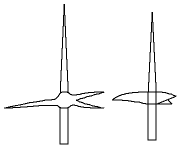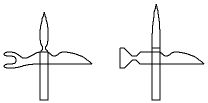Polearm
Contents
A polearm is a type of weapon that appears in NetHack. literally a weapon on a pole. There is an abundance of polearm types in NetHack. This is another feature of the game that echoes early editions of Dungeons & Dragons, which were infamous for giving stats for many exotic polearms, while describing none of them.
Monsters will attempt to use polearms in the following order: halberd, bardiche, spetum, bill-guisarme, voulge, ranseur, guisarme, glaive, lucern hammer, bec de corbin, fauchard, partisan, followed by the lance; and so this list is roughly from best to worst. Polearms can only be used by strong monsters without a shield.
The lance is, in real life, a polearm, but in NetHack it uses the lance skill instead of the polearm skill, due to its very different usage: by mounted soldiers instead of against them.
Generation
Collectively, polearms make up about 6.4% of all randomly generated weapons (on the floor, as death drops, or in shops). The probabilities of each type range from 0.4% to 0.8%.
A few types of polearms are more common because they appear in the starting inventory of certain monsters. Ranseurs, partisans, glaives, and spetums are the usual starting weapons of trolls.[1] Lucern hammers may also be generated as a fall-back starting weapon for strong monsters that lack default weapons.[2]
Watchmen and soldiers in the Yendorian Army often start with a random polearm.[3]
Comparison table
| Name | Value | Weight | Prob (%) | Sdmg | Savg | Ldmg | Lavg | Material | Appearance | Tile | Glyph |
|---|---|---|---|---|---|---|---|---|---|---|---|
| halberd | 10 | 150 | 8 | d10 | 5.5 | 2d6 | 7 | iron | angled poleaxe | ) | |
| bardiche | 7 | 120 | 4 | 2d4 | 5 | 3d4 | 7.5 | iron | long poleaxe | ) | |
| bill-guisarme | 7 | 120 | 4 | 2d4 | 5 | d10 | 5.5 | iron | hooked polearm | ) | |
| ranseur | 6 | 50 | 5 | 2d4 | 5 | 2d4 | 5 | iron | hilted polearm | ) | |
| voulge | 5 | 125 | 4 | 2d4 | 5 | 2d4 | 5 | iron | pole cleaver | ) | |
| guisarme | 5 | 80 | 6 | 2d4 | 5 | d8 | 4.5 | iron | pruning hook | ) | |
| lucern hammer | 7 | 150 | 5 | 2d4 | 5 | d6 | 3.5 | iron | pronged polearm | ) | |
| spetum | 5 | 50 | 5 | d6+1 | 4.5 | 2d6 | 7 | iron | forked polearm | ) | |
| bec-de-corbin | 8 | 100 | 4 | d8 | 4.5 | d6 | 3.5 | iron | beaked polearm | ) | |
| glaive (naginata) | 6 | 75 | 8 | d6 | 3.5 | d10 | 5.5 | iron | single-edged polearm | ) | |
| fauchard | 5 | 60 | 6 | d6 | 3.5 | d8 | 4.5 | iron | pole sickle | ) | |
| partisan | 10 | 80 | 5 | d6 | 3.5 | d6+1 | 4.5 | iron | vulgar polearm | ) |
Polearms skill
| Polearms | |
|---|---|
| Max | Role |
| Basic | |
| Skilled | |
How skill affects range when applying a polearm:
SXXXS
UX@XU
SXXXS
ESUSE
The @ is where your character is standing. Spaces marked with a X are too close to be hit, spaces marked with a U can be hit even while Unskilled, spaces marked with a S can only be hit when Skilled, and spaces marked with a E can only be hit when Expert. No role in vanilla NetHack can become Expert in polearms, but Knights can become Expert in lances, which use the same mechanic.
All of the weapons listed on this page use the polearms skill:
- halberd
- bardiche
- spetum
- ranseur
- partisan
- voulge
- glaive
- fauchard
- guisarme
- bill-guisarme
- lucern hammer
- bec-de-corbin
There are no artifact polearms.
Mechanics
Polearms are capable of attacking enemies from two squares away, but the procedure for using them is different from other weapons. A polearm must be wielded (like any weapon), and then applied via the a command each time you want to strike. Attacking this way doesn't trigger passive attacks, but the polearm itself is still subject to erosion and loss of enchantment from a disenchanter. Pounding with a polearm while standing on Elbereth can cause it to fade and reduce your alignment record, just like attacking in melee.
If you are mounted, you may use polearms for melee attacks in the usual way (which does trigger passive attacks), but simply walking into an opponent on foot will only bash them with the pole; this deals d2 damage, with no bonuses, and does not train polearm skill.
Strategy
A character with a mount could make a polearm their primary weapon. Polearms deal less damage than other two-handed weapons in most circumstances, but they are an attractive option for roles such as Rangers and Wizards, who can ride but are restricted in most of the better melee weapon skills, and the ability to transition from pounding to melee without switching weapons is a tactical advantage. You'll need a backup weapon in case you're dismounted.
One of the great uses of polearms is not for fighting mounted opponents, but for fighting sea monsters, since staying two squares away from water makes a character immune to their drowning attack. If you have no simpler method for dealing with the sea monsters, it can be worthwhile to grab the best polearm you find and spend some time training with it before going to a level with open water.
In terms of differences between polearms, the halberd deals the most damage against small monsters, and the bardiche against large monsters; however, these are also among the heaviest options. The spetum deals high damage to both categories for only 50 weight; the ranseur is also a respectable lightweight polearm. The bec-de-corbin and lucern hammer offer poor damage for such heavy weapons.
Packed rooms
In leprechaun halls, throne rooms, and other rooms where every space is filled with monsters, a character with stealth can use polearms to attack monsters behind other monsters, protecting themselves from being attacked, and in some cases, preventing the target from moving.
Origin
Polearms were popular in warfare for combating mounted soldiers, and those with heavy armor. The polearms (arms on poles) increased leverage for cutting the armor, and increased reach for reaching above the horse.
As time went on the various different weapon types borrowed heavily from each other and began to look like each other, which has led to a great deal of confusion over classification. Warfare is, after all, a ruthlessly pragmatic matter, and classification is a hobby for comfortable people after the dust has settled. If you search the internet now for examples of these weapons, you are likely to see weapons completely mislabeled as something different.
The term "poleaxe" seems to mean an axe on a pole, and that is how it is used in NetHack's descriptions. However, the term in real life is considered a corruption of "pollax", the "poll" part meaning "head", denoting originally a tool for slaughtering animals by hitting them in the head with a spike (whence the verb "to poleaxe"). As with many other agricultural tools, it became yet another military polearm.
Halberd
Bardiche
Spetum
Ranseur
Partisan
Voulge
Glaive
Fauchard
Guisarme
Bill-guisarme
Lucern hammer
| ) | |
|---|---|
| Name | lucern hammer |
| Appearance | pronged polearm |
| Damage vs. small | 2d4 |
| Damage vs. large | d6 |
| To-hit bonus | +0 |
| Weapon skill | polearm |
| Size | two-handed |
| Base price | 7 zm (+10/positive enchant) |
| Weight | 150 |
| Material | iron |
Despite the name, the lucern hammer is not really a hammer, and does not use the hammer skill. This confusion may have been responsible for the creation of Thunderfist. Similar confusion was common among players of the first edition of Advanced Dungeons & Dragons. AD&D cleric characters were denied the use of sharp weapons, restricting them generally to maces and war hammers. Any number of early clerics therefore ended up carrying around a lucern "hammer", which did more damage than a traditional war hammer.
The lucern hammer is vaguely similar to the halberd, only instead of an axe blade, it presents a three-pronged hammer to its victim (hence the pronged polearm designation).
Bec-de-corbin
| ) | |
|---|---|
| Name | bec-de-corbin |
| Appearance | beaked polearm |
| Damage vs. small | d8 |
| Damage vs. large | d6 |
| To-hit bonus | +0 |
| Weapon skill | polearm |
| Size | two-handed |
| Base price | 8 zm (+10/positive enchant) |
| Weight | 100 |
| Material | iron |
The bec-de-corbin (literally "crow's beak") looks extremely similar to the lucern hammer; however the hammer side was sometimes blunt instead of pronged. The distinguishing characteristic though is that the spike was a thick beak-like shape designed only for puncturing (armor, or whatever). This is why it is the beaked polearm. The beak was the primary mode of attack; the hammer or claw was secondary. The spear tip was also generally less pointy than that of the lucern hammer.
SLASH'EM
UXXXU
UX@XU
UXXXU
UUUUU
In SLASH'EM, the range of the polearm is expanded and not restricted by skill level.
A new role, the Yeoman, can reach Expert skill at polearms, and begins play with a +1 partisan.
Reaper is a lawful artifact halberd with a high bonus to damage.
Encyclopedia entry
Many of the weapons of the Middle Ages were poled or long-shafted
arms. Unlike the ancient spear or javelin, however, they were not
intended to be thrown. Some were devices with simple single- or
double-edged blades and nothing more, while others combined
the pick, spear, and hammer or axe all in one weapon.
References
This page is based on a spoiler by Tom Fine, available at http://hea-www.harvard.edu/~fine/Fun/polearms.html
This page may need to be updated for the current version of NetHack.
It may contain text specific to NetHack 3.6.0. Information on this page may be out of date.
Editors: After reviewing this page and making necessary edits, please change the {{nethack-360}} tag to the current version's tag or {{noversion}} as appropriate.


